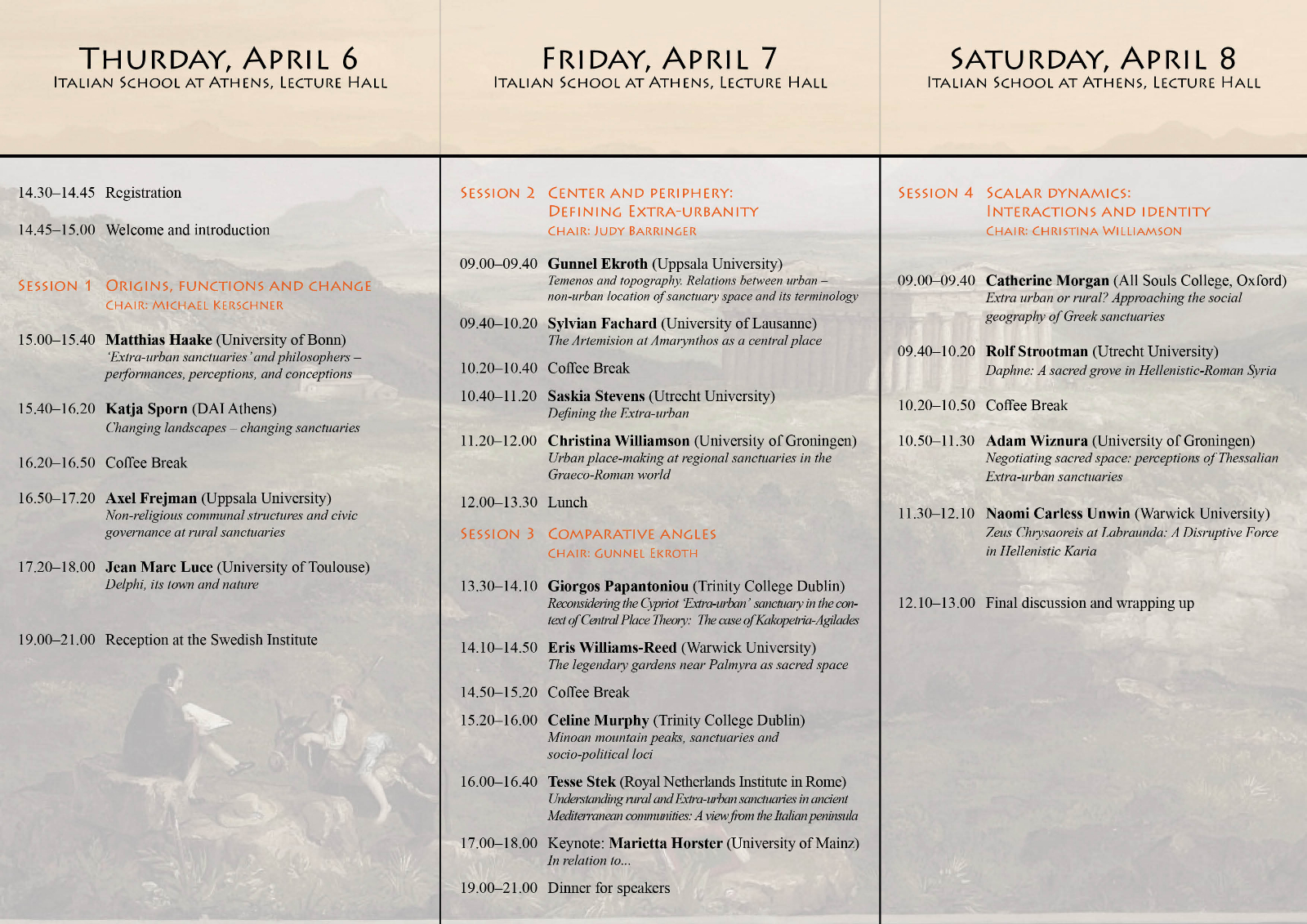Session 2: Center and Periphery: Defining Extra-urbanity

Abstracts of Session Papers
Friday 2023-04-07 | 09:00 | 09:40
Temenos and topography. Relations between urban – non-urban location of sanctuary space and its terminology
Gunnel Ekroth (Uppsala University)
Abstract
An opposition between city and countryside is often emphasized in scholarship on ancient Greek religion. The difficulties of actually applying such a dichotomy has been brought out by several scholars, who instead highlight the need to consider the local dimensions of ancient Greek religion and the idiosyncrasies of each city, community and context.
This paper will address the supposed importance of the city-country or urban-non-urban division from another perspective, that of the terminology of sanctuary space. Greek sanctuaries could be designated by a range of terms, such as hieron, temenos, abaton, alsos, heroon and sekos, as well as be named after the worshipped deity, like Theseion, Aphrodision or Pythion. My particular focus will lie on the use and meaning of the term temenos in the epigraphical record. The most common and generic Greek term for a sanctuary was hieron, but why are some sanctuaries also, only or never called temenos? To what extent is the choice of terminology related to the location or the sanctuary? Or are there other factors at play, such as their importance, size and appearance of the sanctuary, or even the deity worshipped? The question is if the modern notion of extra-urban sanctuaries in any way can be connected to manner in which ancient Greeks called their sanctuaries and if there was an emic Greek designation of sanctuary space which reflects or captures a perception of extra-urbanity.
Friday 2023-04-07 | 09:40 | 10:20
The Artemision at Amarynthos as a central place
Sylvian Fachard (University of Lausanne)
Friday 2023-04-07 | 10:20 | 10:40
Friday 2023-04-07 | 10:40 | 11:20
Defining the Extra-urban
Saskia Stevens (Utrecht University)
Abstract
This contribution will examine the role(s) the extra-urban space played in the human and divine landscape of ancient cities. Commonly defined as pro-asteion or pro-polis in the Greek world, and suburbium or peri-urban area in Roman examples, the emphasis has been all too strongly on the dichotomy between urban and non-urban, highlighting a landscape that is falling short of urban elements. By introducing the idea of the urban borderscape, this paper will turn its attention to the active role the extra-urban played, and explore agency, interaction and experiences within that borderscape. Drawing from archaeological and epigraphic data from the Greco-Roman world, this paper aims to illustrate that the extra-urban was not distant at all, but a multifaceted space full of interaction, fulfilling a crucial and unique role in the wider urban landscape.
Friday 2023-04-07 | 11:20 | 12:00
Urban place-making at regional sanctuaries in the Graeco-Roman world
Christina Williamson (University of Groningen)
Abstract
Sacred landscapes were affected by the wave of urban foundations, especially in the Hellenistic era. Deities with a regional attraction were yoked to the new political body to become its new face, even though their sanctuaries were at a distance from the urban nucleus. But labelling such sanctuaries as extra-urban belies their role as hyperurban centers of gravity, places that came to represent the deepest values and aspirations of their cities. Which strategies and media were connected in their transformations, and by whom? In this paper I sketch three different case studies across time and space that show a pattern of ritual practices: Mount Lykaion and Megalopolis, Mên Askaenos and Antioch, and the Asklepieion and Pergamon. I then discuss the processes of assimilation through the lens of urban place-making, which allows us to better identify the different means and levels of agencies involved in the transitioning of these sacred centres into hyperurban shrines.
